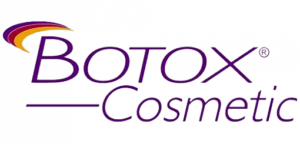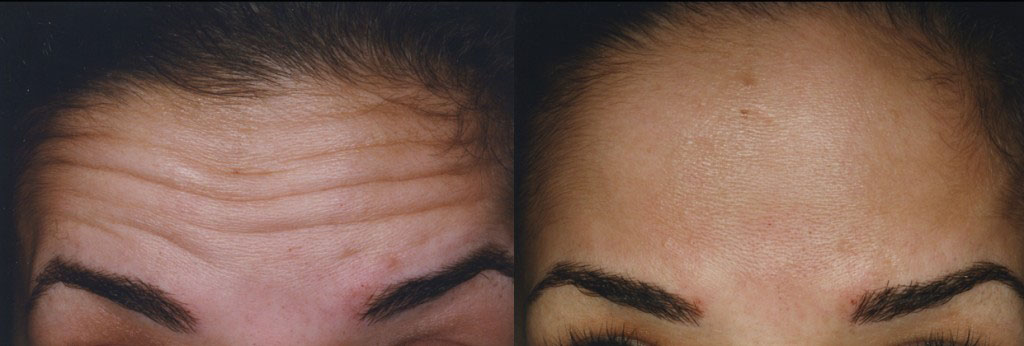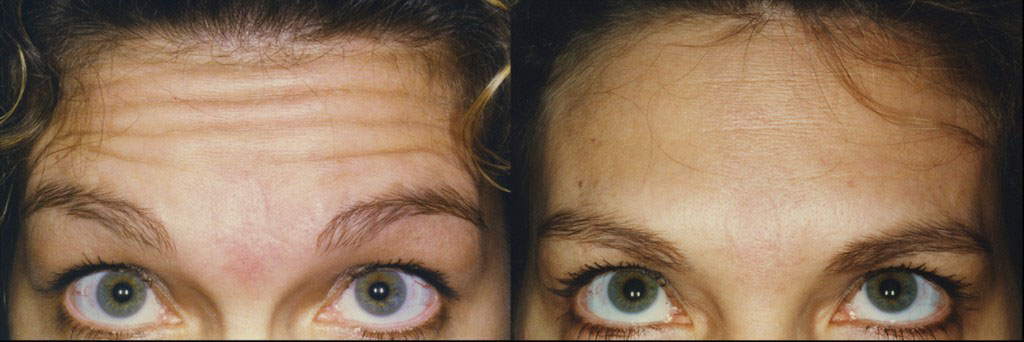How Does Botox® Work?
By preventing the release of a neurotransmitter called acetylcholine, Botox® actually paralyzes or weakens muscle contractions responsible for facial and neck wrinkling. One of the most important neurotransmitters in the body, acetylcholine (ACh) acts like s a chemical messenger that stimulates muscle cell and facilitates the transmission of nerve impulses. ACh is also necessary for optimal bladder, stomach and heart functioning because of its ability to send signals from motor nerves to muscles.
By relaxing muscles and inhibiting muscle contractions, Botox® effectively prevents the appearance of wrinkles and gives the face and neck a smoother, younger appearance. In addition, Botox® also keeps new wrinkles from forming by greatly reducing muscle pull on the skin. When skin stays smoother and wrinkle-free over time with regular Botox® injections, patients find that the skin remains softer and more hydrated as well.
Uses for Botox
Forehead lines, frown lines, and crow’s feet (glabellar lines) are the most commonly treated areas. The people who get the best results are those whose wrinkles appear when their facial muscles are contracting to make facial expressions. Wrinkles which are present all the time are slower to improve, and may not disappear completely.
The procedure takes about 10 to 30 minutes. It takes about two weeks to see the full effects. Results last three to four months. It’s recommended that the next treatment should be administered when the muscles in the treated areas of the face begin to contract again. With repeat treatments the muscles may thin, and the effects of therapy may last longer.
When used for excessive underarm sweating, the toxin is injected in the armpit, just below the skin. It does not relieve the problem 100%, and the effects are temporary, so your dermatologist will often recommend treatments to accompany botulinum toxin therapy for excessive armpit sweating.
Botox Injections for Neck Enhancement
Due to aging and/or excessive exposure to UV rays, the skin on the neck may develop wrinkles and an unattractive condition called “neck banding”. On the front of the neck are two “platysmal” muscles that tend to sag and jut as we get older, especially in women. The appearance of this “turkey neck” can add years to your true age because it also encourages the skin directly under the chin to droop and wrinkle. Fortunately, Botox injections can dramatically improve the weakness of neck’s medial bands by preventing ACh release and paralyzing the muscles’ ability to contract. This procedure also eliminates those fine horizontal neck lines that further age your appearance
Botox Brow Lifts
Brow and forehead lifts using Botox can minimize frown lines and creases lining the forehead as well as elevate the eyebrows to give you a more youthful, alert appearance. As an affordable and pain-free alternative to actual cosmetic surgery, brow lifts are especially effective at raising droopy eyelids and relaxing muscles controlling the eyebrows so that your former, sagging brow arch is higher. Women undergoing Botox brow lifts often find that it is easier to achieve the perfect-shaped eyebrow arch as a result of Botox injections smoothing and rejuvenating skin.
Alternative Benefits of Botox
Patients receiving Botox injections for cosmetic purposes may also experience health benefits related to existing medical conditions. For example, Botox has been found to relieve the severity and frequency of migraine headaches by blocking nerve impulses that cause muscles to twitch and contract during a migraine attack.
Other health benefits patients may experience following a Botox treatment session include decrease in muscle spasms affecting various parts of the body, relief from jaw tension or TMJ pain and reduced arthritis symptoms. In addition, men who have enlarged prostates may notice less swelling in that area after an injection.
Psychologically, Botox treatments can work miracles with a patient’s self-esteem by restoring confidence and a sense of personal satisfaction about his or her appearance. Interestingly, a number of research studies examining the way we respond to smoother, younger-looking and less wrinkled faces has found that people receiving Botox treatments are frequently the recipients of more positive interactions with others simply because people perceive faces that do not appear to be frowning all the time (due to wrinkled and sagging skin) as more approachable and self-assured.
10 Essential Facts about Botox®
- Between 2002 and 2012, approximately 12 million Botox® treatments have been administered to men and women for cosmetic purposes.
- According to an ASERF (Aesthetic Surgery Education and Research Foundation) survey conducted in 2005, 280 out of 303 patients were extremely satisfied with results obtained by Botox injection.
- Although Botox® incorporates the Clostridium botulinum bacterium as one of its ingredients, this same toxin responsible for botulism is actually beneficial for treating a variety of medical issues when provided in smaller doses. In fact, many people do not know that Botox® is also given to people suffering from cervical dystonia, strabismus (crossed eyes), hyperhydrosis (excessive perspiration), overactive bladder and an odd condition called blepharospasm, which causes uncontrollable blinking.
- Botox® CANNOT give you food poisoning.
- Skin rejuvenating results from Botox® injections may last up to nine months. To maintain fresh, smooth, wrinkle-free skin, most patients need to have additional injections every five to six months.
- There is no recovery time with Botox® treatments. You will begin to notice less wrinkling of your skin within two to three days following the procedure.
- Side effects are minimal, with the most common being slight swelling, bruising or redness around the injection site. Intensity of these side effects depend on where the injection is given.
- Botox® was originally approved by the FDA to remove wrinkles in the glabella area, or the space between the brows. However, it proved so highly effective at eliminating deep wrinkles, doctors began using it to remove other facial wrinkles
- Botox® treatment sessions generally last between 10 minutes to one hour, depending on how many injections are desired.
- Patients do not have to prepare in any way on the day a Botox injection is scheduled. Just come to Mayoral Dermatology Services, visit with the doctor and be on your way in no time.
Side effects of Botox Injections
Side effects are rare, but can include drooping of the upper eyelids or brows. If that occurs, it will resolve without treatment, but sometimes eye drops are necessary, or additional botulinum toxin is administered into nearby muscles. There may be some bruising and swelling. Ice applied to the area for 10 to 15 minutes every few hours is helpful. Botulinum toxin can impair vision or depth perception. Be careful about driving or doing anything that requires you to see clearly.
What to know Before treatment
For two weeks before treatment, no aspirin, ibuprofen (e.g. Motrin), or naproxen (Aleve), should be taken because they increase the chance of bruising and bleeding. You should tell your doctor about all the medications (prescription or over the counter), herbs, and/or dietary supplements you consume.
For hyperhidrosis, shave underarms 24 hours before your treatment, and do not use deodorant or antiperspirant for 24 hours before your appointment.
What to do After treatment
You should not lie down for at least four hours. Don’t massage the areas treated, or apply heat to them. Don’t engage in activity which can cause flushing, such as strenuous exercise, drinking alcohol, or using a hot tub. Avoid using antiperspirants or deodorants for 24 hours after treatment for excessive sweating. Most people can return to their usual activities immediately after treatment.
Many consumers fear that they will be unable to have normal facial expressions. To avoid or minimize the effect of botulinum toxin on facial expressions, your dermatologist carefully controls the dose administered, and the placement of the toxin in the intended muscles only. The toxin does not affect sensation in the skin.
Safety of Botox
Botulinum toxin therapy has an excellent safety record, when administered by a dermatologist, to treat signs of aging or for excessive sweating. In those settings, the serious side effects on breathing or swallowing have never been reported.
Hairdressers, cosmeticians, and many other people without training are offering botulinum toxin therapy. It should be performed by someone who has knowledge of facial musculature – a board-certified dermatologist, plastic surgeon, or other qualified physician. Botulinum toxin is not injected directly into obvious frown lines, but into facial muscles contributing to the wrinkling. The cost of treatments is widely variable. When used strictly for cosmetic purposes, most health insurance plans do not cover the cost.
Botulinum toxin should not be used during pregnancy or breastfeeding. It is not recommended for patients under 18 years of age.
Products which claim to be botulinum toxin are sold on line, but a medical license is required to obtain the toxin. Online or over-the-counter substances which do not require a license to obtain should not be considered safe or effective. Their composition is often unknown.
Lets take an In-Depth look at Botox
Botulinum toxin is a nerve-poisoning protein produced by the bacterium Clostridium botulinum. It’s the most acutely lethal toxin known. It blocks nerves from sending signals to muscle to contract. When botulinum toxin is administered, muscles stay relaxed, smoothing wrinkles. In the armpits, the toxin blocks, but does not eliminate, sweat production.
There is an ever-growing list of indications and conditions for which botulinum toxin may have a role in treatment. Your dermatologist treats two of those conditions: excessive underarm sweating, and facial wrinkling.
To ensure safety, tell your doctor if you have:
- amyotrophic lateral sclerosis (ALS or Lou Gehrig’s disease)
- myasthenia gravis
- Lambert-Eaton syndrome
- a breathing disorder, such as asthma or emphysema
- problems with swallowing
- facial muscle weakness (droopy eyelids, weak forehead muscles, trouble raising your eyebrows)
- bleeding problems
- heart disease
- if you have had surgery or plan surgery (especially facial surgery)
- if you have received botulinum toxin injections previously
- if you’ve ever had side effects after receiving botulinum toxin in the past
Tell your doctor about any and all medicines you take, including prescription and nonprescription medicines, vitamins, herbs, and other dietary supplements.
Especially tell your doctor if you:
- have received any other botulinum toxin product(s) in the last four months
- have recently received an antibiotic by injection
- take muscle relaxants
- take an allergy or cold medicine
- take a medication for sleep
- take aspirin-like products or anti-coagulants (blood thinners)
Botulinum toxin can spread to other body areas beyond where it was injected, causing life-threatening side effects in some people. After you receive treatment, get emergency medical help if you have any of these signs of an allergic reaction to botulinum: hives, difficulty breathing, feel like you might pass out, or swelling of your face, lips, tongue or throat.
Less-threatening side effects, which may occur from several hours to several weeks after an injection, and which should be reported to your physician, include:
- unusual or severe muscle weakness (especially in a body area that was not injected with the medication)
- trouble breathing, talking, or swallowing
- hoarse voice
- drooping eyelids
- loss of bladder control
- eyelid swelling, crusting or drainage from your eyes, problems with vision
- pain or burning when you urinate, little or no urinating
- chest pain
- irregular heartbeats
Common side effects may include:
- muscle weakness near where the medication was injected
bruising, bleeding, pain, redness, or swelling where the injection was given
- headache
- muscle stiffness
- neck or back pain
- pain in your arms or legsv
- increased sweating in areas other than the underarms
- cold symptoms, such as nasal congestion, sneezing, cough, sore throat
These are not all the side effects. Call your doctor for medical advice about side effects. You may report side effects to the United States Food and Drug Administration (FDA) at 1-800-FDA-1088.
References
1. Small R. Botulinum toxin injection for facial wrinkles. Am Fam Physician. 2014 Aug 1; 90(3):168-175
2. Small R. Aesthetic procedures in office practice. Am Fam Physician. 2009;80(11):1231-1237
3. American Society for Aesthetic Plastic Surgery, Cosmetic Surgery National Data Bank Statistics 2013. http://www.surgery.org/media/statistics
4. Jankovic J. Botulinum toxin in clinical practice. J Neurol Neurosurg Psychiatry. 2004; 75:951-957




